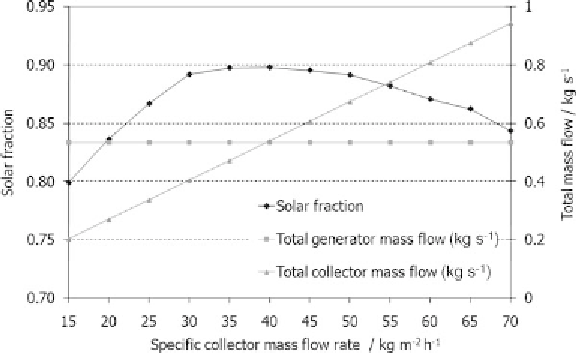Environmental Engineering Reference
In-Depth Information
Figure 6.11
Influence of collector mass flow on solar fraction for constant generator inlet temperature
the absorber and condenser temperature levels, the type and control of the recooling
system are decisive for performance. In this work, wet and dry cooling towers have
been modelled. The generator temperature level mainly depends on the chosen control
strategy. In the simplest case, the inlet temperature to the generator is fixed, which
means high collector temperatures and poorer performance. An improved control
strategy allows a temperature reduction in partial load conditions.
For an annual cooling energy demand of nearly 14MWh and an average COP of
0.7, the system requires about 20MWh of heating energy. To achieve a solar fraction
of 80% for the given cooling load profile, a collector surface area of 48.5m
2
and a
storage tank volume of 2m
3
is required, if the generator is always operated at an inlet
temperature of 85
◦
C. For the constant generator inlet temperature level of 85
◦
C, the
specific collector energy yield is only 393 kWhm
−
2
a
−
1
for an annual irradiance of
1746 kWhm
−
2
a
−
1
, that is the solar thermal system efficiency is 22% (Case 0). If the
collector field were also used for warm water heating and heating support the annual
yield could be significantly increased (to about 1000 kWhm
−
2
a
−
1
).
For such constant high generator inlet temperatures and a low flow collector system
of 15 kgm
−
2
h
−
1
mass flow, the temperature levels in the collector are often above
100
◦
C if the cooling demand is low and the solar thermal energy production high.
An increase in mass flow reduces the problem: by doubling the collector mass flow
and thus lowering average solar collector temperatures, the solar fraction for the same
collector surface area rises to 90% (see Figure 6.11). Using the higher mass flow of
30 kgm
−
2
h
−
1
and constant generator temperatures, the collector surface area can be
reduced to 33.1m
2
and the collector energy yield rises to 584 kWhm
−
2
a
−
1
(Case 1).
If the controller allows a reduction of generator temperature for partial load condi-
tions, the performance improves due to lower average temperature levels and low-flow

Search WWH ::

Custom Search